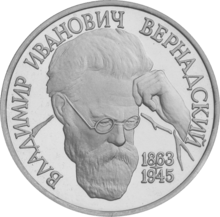Biogeochemistry
Biogeochemistry is the scientific discipline that involves the study of the chemical, physical, geological, and biological processes and reactions that govern the composition of the natural environment (including the biosphere, the cryosphere, the hydrosphere, the pedosphere, the atmosphere, and the lithosphere). In particular, biogeochemistry is the study of the cycles of chemical elements, such as carbon and nitrogen, and their interactions with and incorporation into living things transported through earth scale biological systems in space through time. The field focuses on chemical cycles which are either driven by or influence biological activity. Particular emphasis is placed on the study of carbon, nitrogen, sulfur, iron, and phosphorus cycles. Biogeochemistry is a systems science closely related to systems ecology.
History

The founder of biogeochemistry was Russian and Ukrainian scientist Vladimir Vernadsky whose 1926 book The Biosphere,[1] in the tradition of Mendeleev, formulated a physics of the Earth as a living whole. Vernadsky distinguished three spheres, where a sphere was a concept similar to the concept of a phase-space. He observed that each sphere had its own laws of evolution, and that the higher spheres modified and dominated the lower:
- Abiotic sphere – all the non-living energy and material processes
- Biosphere – the life processes that live within the abiotic sphere
- Nöesis or noosphere – the sphere of human cognitive process
Human activities (e.g., agriculture and industry) modify the biosphere and abiotic sphere. In the contemporary environment, the amount of influence humans have on the other two spheres is comparable to a geological force (see Anthropocene).
Early development
The American limnologist and geochemist G. Evelyn Hutchinson is credited with outlining the broad scope and principles of this new field. More recently, the basic elements of the discipline of biogeochemistry were restated and popularized by the British scientist and writer, James Lovelock, under the label of the Gaia Hypothesis. Lovelock emphasizes a concept that life processes regulate the Earth through feedback mechanisms to keep it habitable.
Research
There are biogeochemistry research groups in many universities around the world. Since this is a highly inter-disciplinary field, these are situated within a wide range of host disciplines including: atmospheric sciences, biology, ecology, geomicrobiology, environmental chemistry, geology, oceanography and soil science. These are often bracketed into larger disciplines such as earth science and environmental science.
Many researchers investigate the biogeochemical cycles of chemical elements such as carbon, oxygen, nitrogen, phosphorus and sulfur, as well as their stable isotopes. The cycles of trace elements such as the trace metals and the radionuclides are also studied. This research has obvious applications in the exploration for ore deposits and oil, and in remediation of environmental pollution.
Some important research fields for biogeochemistry include:
- modelling of natural systems
- soil and water acidification recovery processes
- eutrophication of surface waters
- carbon sequestration
- Environmental remediation
- global change
- climate change
- biogeochemical prospecting for ore deposits
- Soil chemistry
See also
- Acid rain
- Atlantic Data Base of Exchange Processes at the Deep Sea Floor
- Carbon sink
- Ecosystem model
- Edaphology
- Environmental engineering science
- Geochemistry
- Geophysiology
- GEOTRACES
- Hydrogen isotope biogeochemistry
- IMBER
- Marine biogeochemical cycles
- Pedology (soil study)
- Physical impacts of climate change
References
Citations
- Vladimir I. Vernadsky, 2007, Essays on Geochemistry & the Biosphere, tr. Olga Barash, Santa Fe, NM, Synergetic Press, ISBN 0-907791-36-0 (originally published in Russian in 1924)
Representative books and publications
- Vladimir I. Vernadsky, 2007, Essays on Geochemistry and the Biosphere, tr. Olga Barash, Santa Fe, NM, Synergetic Press, ISBN 0-907791-36-0 (originally published in Russian in 1924)
- Schlesinger, W. H. 1997. Biogeochemistry: An Analysis of Global Change, 2nd edition. Academic Press, San Diego, Calif. ISBN 0-12-625155-X.
- Schlesinger, W. H., 2005. Biogeochemistry. Vol. 8 in: Treatise on Geochemistry. Elsevier Science. ISBN 0-08-044642-6
- Vladimir N. Bashkin, 2002, Modern Biogeochemistry. Kluwer, ISBN 1-4020-0992-5.
- Samuel S. Butcher et al. (Eds.), 1992, Global Biogeochemical Cycles. Academic, ISBN 0-12-147685-5.
- Susan M. Libes, 1992, Introduction to Marine Biogeochemistry. Wiley, ISBN 0-471-50946-9.
- Dmitrii Malyuga, 1995, Biogeochemical Methods of Prospecting. Springer, ISBN 978-0-306-10682-8.
- Global Biogeochemical Cycles. A journal published by the American Geophysical Union.
- Cullen, Jay T.; McAlister, Jason (2017). "Chapter 2. Biogeochemistry of Lead. Its Release to the Environment and Chemical Speciation". In Astrid, S.; Helmut, S.; Sigel, R. K. O. (eds.). Lead: Its Effects on Environment and Health. Metal Ions in Life Sciences. 17. de Gruyter. doi:10.1515/9783110434330-002. PMID 28731295.
- Woolman, T. A., & John, C. Y., 2013, An Analysis of the Use of Predictive Modeling with Business Intelligence Systems for Exploration of Precious Metals Using Biogeochemical Data. International Journal of Business Intelligence Research (IJBIR), 4(2), 39-53.v .
- Biogeochemistry. A journal published by Springer.